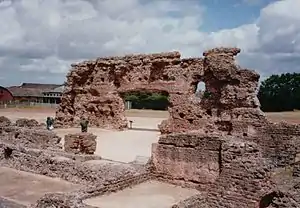Newport Roman Villa
Newport Roman Villa was a Romano-British farmhouse constructed in 280 AD. It is located near to Newport, Isle of Wight.
| Newport Roman Villa | |
|---|---|
 Museum entrance | |
 Location on the Isle of Wight | |
| General information | |
| Location | Isle of Wight, England, UK |
| Coordinates | 50.6945°N 1.2918°W |
| OS grid | SZ500885 |
Discovery and excavation
Newport Roman Villa was unearthed in 1926 when garage foundations were laid by a nearby homeowner.[1][2] The site was excavated and the ground plan of the villa house was uncovered.
Thanks to public interest and the generosity of the developer, the site was preserved and protected by a cover building. It is now a scheduled ancient monument, giving it protected status.[3]
History
Newport Roman Villa was constructed in about 280 AD with local stone including flint, chalk, limestone and greensand with the walls remaining almost at their original height. The building was roofed with massive slabs of Bembridge limestone which needed large roof timbers to support them. Many of these roof slabs had a distinctive shape, pierced with a single hole to take a nail, were found on the site. It is likely the building was the centre of a wealthy estate.[4]
The discovery of fragments of window glass on the site shows that the building had some glazed windows, and remains of painted wall plaster during excavation show that at least some of the rooms had brightly coloured interior walls.
It features a well-preserved Roman bath suite with hypocaust underfloor heating.[4] The furnace for heating the bath suite was outside the back wall of the villa at the end of the bath wing, and a slave would have been responsible for providing it with fuel. The hot air from the furnace passed through an arch at the base of the villa's back wall and circulated under the raised floors of the three rooms.[3]
It remains unknown when life at the villa ended. During excavation, the skull of a woman in her early thirties was found in the corner of one of the rooms. It has been suggested that she was killed during a raid in an abandoned building. However it is also viewed that the abandonment of the island's villas by the middle of the fourth century could be due to economic hardship rather than the threat of attacks by Anglo-saxon raiders.[3]
Museum
The villa has since been reconstructed based on archaeological evidence featuring a Roman kitchen and Roman garden.[5] It is now open to the public usually from around April to October. The villa regularly has over 5,000 visitors per year, with a further 1,400 school children taking part in educational visits.[3] It is located on Cypress Road in Newport on the Isle of Wight in the middle of a residential development.[6]
For 2009 the villa underwent a roof replacement project, involving essential repairs and replacement of the cover-building roof structure to protect it from further weathering. The project has been joint-funded by the Isle of Wight Council and English Heritage, which grant-aided over £40,000 towards costs. The roof has been designed to improve environmental conditions, reducing moisture levels which have contributed to a build-up of algae on the mosaics below.[7]
References
- "Newport Roman Villa - Introduction". www.iwight.com. Archived from the original on 23 November 2008. Retrieved 18 October 2008.
- Stone, Percy (1929). "A Roman Villa at Newport, Isle of Wight". The Antiquaries Journal. 9 (2): 141–151. doi:10.1017/s0003581500050800.
- Isle of Wight Gazette - Friday 17 April - Thursday 30 April 2009 - page 9 - "New roof secures future of mosaics"
- "Newport Roman Villa on AboutBritain". www.aboutbritain.com. Retrieved 18 October 2008.
- "Sessions at Newport Roman Villa". www.carisbrookecastlemuseum.org.uk. Archived from the original on 5 July 2008. Retrieved 18 October 2008.
- "IWight - Location of Newport Roman Villa". www.iow.gov.uk. Archived from the original on 23 December 2012. Retrieved 26 October 2008.
- "Delay to Roman Villa re-opening". Isle of Wight County Press. Retrieved 24 May 2009.
External links
| Wikimedia Commons has media related to Newport Roman Villa. |
- Newport Roman Villa website on the Isle of Wight Council's website - iwight.gov.uk
- Newport Roman Villa - official site

